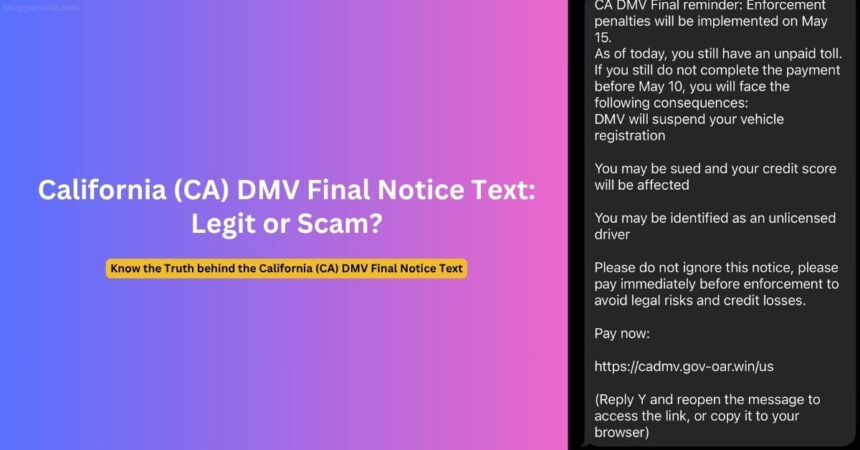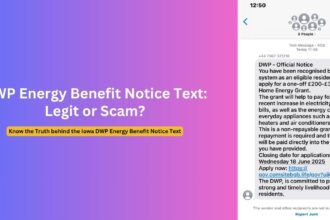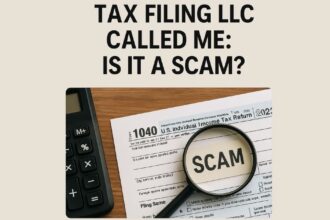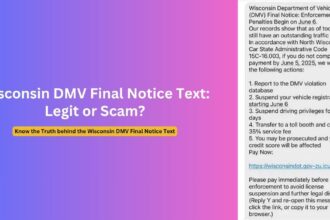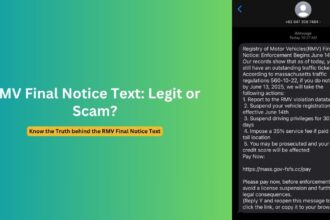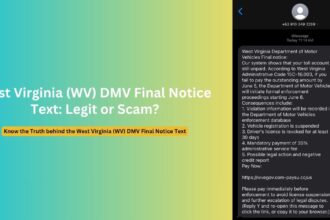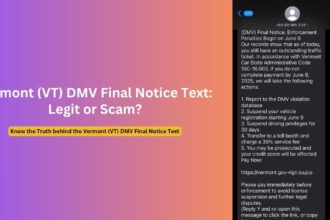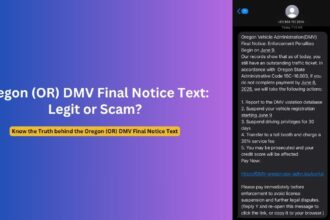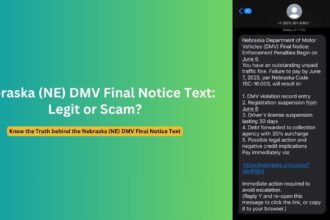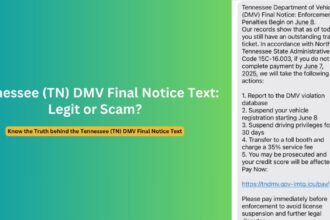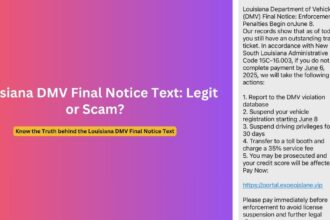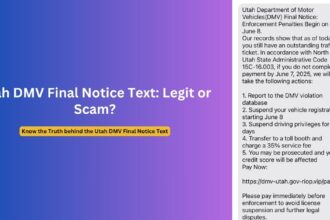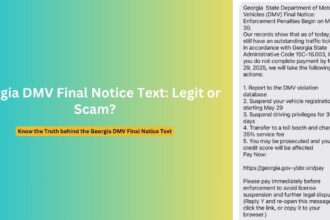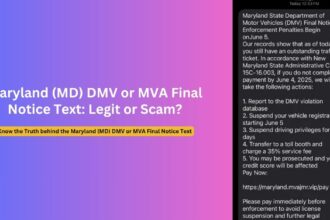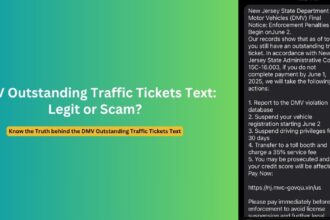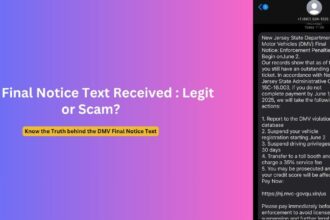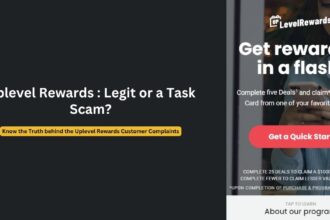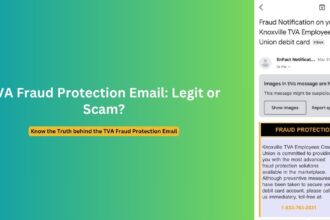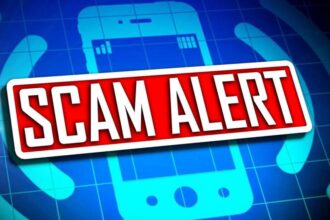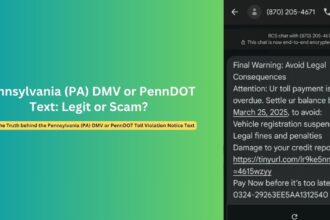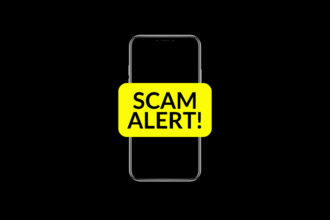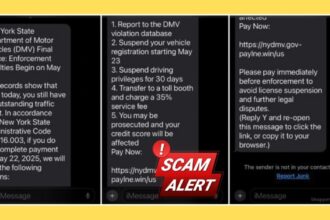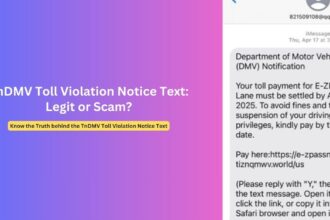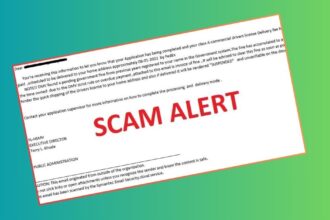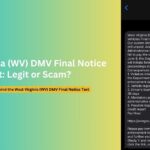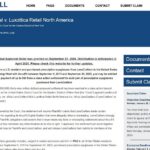A massive text message scam targeting California residents has exploded across the Golden State, with cybercriminals impersonating the California Department of Motor Vehicles (DMV) to steal personal and financial information. Millions of Californians from San Diego to Sacramento have received fraudulent “final notice” messages about alleged unpaid toll accounts and traffic violations, prompting urgent warnings from state law enforcement, the California DMV, and consumer protection agencies statewide.
Overview of the California (CA) DMV Text Scam
The California DMV Final Notice Text Scam represents one of the largest coordinated cyber attacks targeting a single state, specifically designed to exploit California residents through fraudulent text messages claiming to be official communications from the California Department of Motor Vehicles. This sophisticated phishing operation has rapidly spread across all 58 California counties, affecting communities from the Mexican border to the Oregon state line.
The scam particularly exploits Californians’ familiarity with extensive toll road systems, bridge tolls, and complex traffic enforcement throughout the state. Fraudsters create artificial urgency through threatening language about license revocation, vehicle registration suspension, and legal action to pressure victims into providing sensitive personal and financial information through malicious websites designed to appear as legitimate government portals.
California Highway Patrol, California DMV officials, and the Attorney General’s office emphasize unequivocally: The California Department of Motor Vehicles does not send unsolicited text messages regarding traffic violations, toll account balances, outstanding fines, or enforcement actions. All such communications are fraudulent attempts designed to steal personal information and commit serious financial crimes.
Massive Impact Scope Across California
The California DMV traffic tickets text scam has affected:
- Residents across all California counties from Los Angeles to Alpine
- Commuters using California’s extensive toll road and bridge systems
- College students attending University of California and California State University campuses
- Workers commuting across multiple counties in major metropolitan areas
- Tourists and seasonal residents visiting California destinations
- Former California residents maintaining connections to the state
- International residents and immigrants navigating California’s complex DMV system
- Senior citizens who may be more vulnerable to official-sounding government threats
Reports indicate this California department of motor vehicles outstanding traffic ticket text has generated thousands of complaints to California Highway Patrol, the California Attorney General’s office, local police departments, and consumer protection organizations throughout the Western United States.
How the DMV Final Reminder Notice / Outstanding Traffic Ticket Scam Works
The California DMV Final Notice Text Scam employs a sophisticated multi-stage psychological manipulation strategy specifically designed to exploit trust in California’s government institutions and familiarity with the state’s complex transportation infrastructure:
1. Target Identification and Massive Data Collection
Scammers acquire California phone numbers through multiple sophisticated methods targeting the state’s 39+ million residents:
- Data breaches from California businesses, universities, and state contractors
- Social media harvesting targeting California residents and communities across major metropolitan areas
- Public records mining from California government databases, court records, and property records
- Automated generation targeting California area codes (213, 310, 323, 408, 415, 510, 562, 619, 626, 650, 661, 707, 714, 747, 760, 805, 818, 831, 858, 909, 916, 925, 949, 951)
- Purchase of massive contact lists from illegitimate data brokers specializing in California demographics
- Toll road customer database breaches from California transportation authorities
2. Psychological Manipulation and Trust Exploitation
The fraudulent messages trigger immediate emotional responses designed to bypass rational analysis:
- Government Authority: Leverages trust in California state institutions and agencies
- Regional Infrastructure Familiarity: References toll roads, bridges, and traffic systems familiar to California drivers
- Fear Induction: Threatens loss of driving privileges essential for California’s car-dependent culture
- Urgency Creation: Imposes unrealistic deadlines requiring immediate action
- Financial Pressure: Mentions additional fees, service charges, and credit score damage
- Legal Intimidation: References formal enforcement proceedings and potential prosecution under California law
3. Advanced Information Harvesting and Data Collection
Victims who engage with the scam encounter progressive data collection designed to maximize information theft:
- Initial website visit captures comprehensive device information, precise location data, and detailed browsing patterns
- Sophisticated fake verification forms request extensive personal identifying details
- Advanced payment pages capture complete credit card information, banking details, security codes, and billing addresses
- Follow-up communications may request Social Security numbers, driver’s license information, passport data, and additional sensitive information
- Advanced scams may attempt to capture login credentials for legitimate California government websites and financial institutions
4. Comprehensive Financial Exploitation and Identity Theft
Once scammers obtain victim information, they typically engage in multiple forms of serious criminal activity:
- Make immediate unauthorized charges to captured credit cards, bank accounts, and digital payment systems
- Attempt comprehensive identity theft using collected personal identifying information for multiple fraudulent purposes
- Sell complete identity packages to other criminal organizations operating nationally and internationally
- Use victim information for additional targeted fraud schemes including tax fraud, benefit fraud, and loan fraud
- Open new financial accounts, credit lines, loans, and mortgages in victims’ names
- File fraudulent tax returns, unemployment claims, and government benefit applications
Fake Text Message Patterns and Examples
Primary Fake California DMV Text Example:
California Department of Motor Vehicles (DMV) Final notice:
Our system shows that your toll account is still unpaid. According
to California Administrative Code 15C-16.003, if you fail to pay
the outstanding amount by June 5, the Department of Motor Vehicles
will initiate formal enforcement proceedings starting June 6.
Consequences include:
1. Violation information will be recorded in the Department of Motor
Vehicles enforcement database
2. Vehicle registration is suspended
3. Driver’s license is revoked for at least 30 days
4. Mandatory payment of 35% administrative service fee
5. Possible legal action and negative credit report
Pay Now: https://caegov.com-paysu.cc/us
Please pay immediately before enforcement to avoid license suspension
and further escalation of legal disputes.
(Reply Y and re-open this message to click the link, or copy it to
your browser.)
CA DMV Final reminder: Enforcement penalties will be implemented on May 15.
As of today, you still have an unpaid toll. If you still do not complete the payment before May 10, you will face the following consequences:
DMV will suspend your vehicle registration
You may be sued and your credit score will be affected
You may be identified as an unlicensed driver
Please do not ignore this notice, please pay immediately before enforcement to avoid legal risks and credit losses.
Pay now:
https://cadmv.gov-oar.win/us
(Reply Y and reopen the message to access the link, or copy it to your browser)
Alternative California Scam Message Variations:
Bay Area Bridge Toll Scam:
California DMV: Outstanding Bay Bridge toll violation $8.50
FasTrak account suspended. License suspension scheduled June 20, 2025.
Administrative fees now $145.00. Pay immediately: [MALICIOUS LINK]
Southern California Toll Road Version:
CA DMV Alert: Unpaid 91 Express Lanes toll $12.75
Vehicle: [LICENSE PLATE]. Late fees applied: $89.25
Registration hold pending payment: [FRAUDULENT URL]”
Los Angeles Area Parking Citation:
California DMV Final Notice: Unpaid parking citation #LA-2025-XXXX
$275 fine plus administrative costs. Immediate payment required
to prevent registration suspension: [FAKE LINK]
California Highway Patrol Impersonation:
CHP/DMV Joint Notice: Outstanding traffic violation $450
Commercial vehicle safety inspection required. CDL suspension
pending compliance: [SCAM URL]
Registration Renewal Scam:
California DMV: Vehicle registration #8ABC123 expired 60+ days.
$350 late penalty plus towing authorization. Renew immediately:
[MALICIOUS LINK]
Smog Check Violation:
CA DMV Final Warning: Smog check overdue 90+ days.
$500 fine assessed. Immediate compliance required to avoid
registration suspension: [FRAUDULENT URL]
Compliance Notice Scam:
CA DMV Compliance Notice
Your toll account remains past due. After May 11, enforcement may begin, including late fees and registration suspension.
https://rb.gy/dsmhlr?RrZ=Pq9MyO
Act immediately to avoid legal and financial consequences.
Critical Red Flags to Identify DMV Scams
Phone Number and Technical Warning Indicators:
- Non-California origins: Messages not from legitimate California area codes for official state business
- International routing codes: Country codes like +63 (Philippines), +91 (India), +86 (China), +44 (UK)
- Spoofed local numbers: Calls appearing from California but routing through foreign servers and proxy systems
- Bulk messaging timestamps: Identical send times across thousands of recipients indicating automated mass distribution
- Unverified government numbers: Phone numbers not registered with legitimate California state agencies or contractors
Content and Legal Citation Red Flags:
Fabricated Legal References:
- “California Administrative Code 15C-16.003” – This regulation does not exist anywhere in California law
- California uses California Code system with specific code sections (Vehicle Code, Government Code, etc.)
- Real DMV citations reference specific California Vehicle Code sections and subsections
- Legitimate toll violations reference actual authority regulations from specific transportation agencies
- Inconsistent agency mixing combining DMV, CHP, and toll authorities incorrectly
Language and Communication Inconsistencies:
- Generic addressing without specific personal details, vehicle information, violation specifics, or location data
- Grammatical errors and awkward phrasing inconsistent with professional California government communication standards
- Inconsistent formatting compared to authentic California government correspondence and official notices
- Non-standard payment instructions not matching California government transaction protocols and security requirements
- Mixing of agency responsibilities that don’t align with actual California government structure and jurisdiction
Technical and Website Security Red Flags:
- Fraudulent domain structures: Real California government sites use ca.gov exclusively for all official business
- Suspicious URL patterns: Random characters, foreign domain extensions, and non-government hosting services
- Insecure connections: Absence of proper SSL certificates and government-grade security protocols required for official sites
- Broken website functionality: Only payment processing and personal data collection forms work properly on fake sites
- Mobile-specific targeting: Websites designed exclusively for mobile device exploitation and optimized data theft
Procedural and Administrative Red Flags:
- Immediate payment demands: Real violations include mandatory appeal periods, grace periods, and comprehensive due process protections
- Weekend and holiday enforcement timing: California government offices don’t issue urgent enforcement actions during non-business hours
- Text-only official communication: California DMV uses certified mail and official postal service for all legal notices and enforcement
- Lack of specific violation details: Real citations include comprehensive information about time, location, officer, violation code, and appeal procedures
- No legitimate contact information: Authentic notices provide verified phone numbers, addresses, case numbers, and official reference information
How to Identify and Protect Yourself from Fraudulent California (CA) DMV Texts
Verification and Authentication Strategies:
1. Official Channel Verification Protocol
- Contact California DMV directly: 1-800-777-0133
- Visit official website: dmv.ca.gov
- Check driving record through California DMV online portal
- Visit local DMV field office for in-person verification and comprehensive records review
- Contact California Highway Patrol: 1-800-TELL-CHP (835-5247) for fraud reporting and investigation
2. Document and Communication Authentication Process
- Compare message format and language with legitimate California DMV communications you’ve previously received
- Verify any citation or violation numbers through official California court systems, DMV records, and law enforcement databases
- Check for official California state seals, letterhead, and proper contact information on all legitimate communications
- Confirm violation details and locations match your actual driving history, vehicle registration, and documented travel patterns
- Cross-reference dates, times, and locations with your personal records, GPS data, toll records, and travel documentation
Comprehensive Protection Strategies:
Immediate Digital Security Implementation:
- Never click links in unsolicited text messages from any source, especially those claiming government authority or urgent action
- Avoid downloading attachments or files from unknown, suspicious, or unverified sources of any kind
- Don’t provide personal, financial, or identifying information through text, email, or phone unless you initiated contact through verified official channels
- Report suspicious messages immediately to multiple agencies for investigation, community protection, and law enforcement action
Advanced Cybersecurity Protection Measures:
- Enable comprehensive spam filtering and advanced call blocking on all mobile devices and carrier services
- Install reputable cybersecurity applications with real-time threat detection, malware protection, and comprehensive phishing prevention
- Monitor credit reports and financial statements from all three major bureaus monthly for unauthorized activity and suspicious changes
- Set up fraud alerts and comprehensive account monitoring with all financial institutions, credit providers, and government agencies
- Use strong, unique passwords with multi-factor authentication for all online accounts containing sensitive personal, financial, or government information
Financial Security and Identity Protection Protocols:
- Use credit cards instead of debit cards for all online transactions (superior fraud protection and liability limitations)
- Monitor bank accounts, credit card statements, and investment accounts weekly for unauthorized activity and suspicious transactions
- Enable real-time transaction alerts for all accounts above minimal threshold amounts to detect fraud immediately
- Consider comprehensive identity monitoring services if you’re at high risk for identity theft or have been previously targeted by scams
- Maintain updated emergency contact information with all financial institutions, government agencies, and important service providers
What to Do If You Receive the Scam Text
Immediate Response Protocol:
1. Do Not Engage Under Any Circumstances
- Don’t click any links, buttons, or interactive elements contained in the suspicious message
- Avoid replying to the text message in any manner, even to request removal from contact lists
- Don’t call phone numbers provided in the fraudulent communication
- Don’t download attachments, files, or additional content from the message source
- Don’t forward the message to personal contacts (instead, report through official government channels)
2. Report the Scam Through Multiple Official Channels
- Forward the complete text to 7726 (Federal Trade Commission spam reporting system)
- Contact California Attorney General’s Office: 1-800-952-5225 for state-level investigation and consumer protection
- Report to FBI Internet Crime Complaint Center: ic3.gov for federal cybercrime investigation and prosecution
- File detailed complaint with Federal Trade Commission: reportfraud.ftc.gov for consumer protection enforcement
- Contact California Highway Patrol: 1-800-TELL-CHP for criminal investigation and fraud reporting
- Notify California DMV: 1-800-777-0133 to report impersonation of state agency
3. Secure Your Digital Environment and Personal Information
- Mark the message as spam/junk in your messaging application settings and filters
- Block the sender’s number permanently from all future communications and contact attempts
- Delete the fraudulent message completely from your device and any associated cloud backup services
- Run comprehensive security scans on your mobile device using reputable antivirus and anti-malware software
- Update your device software and applications to the latest security patches and vulnerability protections
If You Already Interacted with the California DMV Scam:
Emergency Damage Control and Protection Actions:
- Contact all banks, credit unions, and credit card companies immediately to report potential fraud and request emergency account protections
- Cancel or freeze any payment cards, bank accounts, or financial instruments that may have been compromised during scam interaction
- Change passwords immediately for all online accounts, prioritizing financial accounts, email accounts, and government service portals
- Monitor all financial accounts continuously for unauthorized activity, suspicious transactions, new account openings, or credit inquiries
- Document all interactions and financial impacts related to the scam for law enforcement, financial institutions, and potential legal proceedings
Comprehensive Follow-up Protection and Recovery:
- Place fraud alerts immediately with all three major credit reporting bureaus (Experian, Equifax, TransUnion) to prevent unauthorized account openings
- File detailed police report with local California law enforcement for official documentation and criminal investigation
- Consider comprehensive identity monitoring and restoration services for ongoing protection against future fraud attempts and continued monitoring
- Report any financial losses to your insurance company if you have identity theft, cyber liability, or comprehensive coverage
- Maintain detailed, organized records of all scam-related communications, financial impacts, recovery efforts, and law enforcement interactions for potential legal action
Statewide Campaign: California Cities and Communities Under Massive Attack
Major Metropolitan Areas and Communities Experiencing Extensive Scam Activity:
The California DMV Final Notice Text Scam has been extensively reported across California’s massive and diverse population centers, affecting communities from major metropolitan areas to small rural towns throughout the state:
Los Angeles County Region:
- Los Angeles residents report tens of thousands of fraudulent text message campaigns targeting the nation’s second-largest city
- Beverly Hills and West Hollywood communities heavily targeted by scammers exploiting high-income demographics
- Long Beach and Pasadena residents receive numerous scam attempts targeting major port and academic communities
- Glendale and Burbank areas affected by coordinated attacks targeting entertainment industry workers
- Torrance and Carson communities experience increased fraudulent activity near major transportation corridors
- Pomona and Lancaster residents report suspicious text messages targeting inland communities
- Santa Monica and Manhattan Beach coastal areas heavily targeted during tourist seasons
Orange County Area:
- Anaheim residents, including Disneyland area workers and tourists, extensively targeted by sophisticated scam operations
- Santa Ana and Irvine communities report multiple scam incidents targeting diverse residential and business populations
- Huntington Beach and Newport Beach coastal residents affected by coordinated attacks during peak tourist periods
- Garden Grove and Westminster areas experience increased scam activity targeting immigrant communities
- Mission Viejo and Laguna Hills suburban communities report fraudulent text messages targeting affluent demographics
- Fullerton and Brea residents receive suspicious messages targeting transportation corridor workers
San Diego County Region:
- San Diego residents receive extensive fraudulent text campaigns targeting military personnel and border community workers
- Chula Vista and National City communities heavily targeted by scammers exploiting proximity to Mexican border
- Oceanside and Carlsbad residents affected by scam operations targeting North County coastal communities
- El Cajon and La Mesa areas experience increased fraudulent activity targeting inland suburban populations
- Escondido and Vista communities report suspicious text messages targeting agricultural and service industry workers
- Coronado and Imperial Beach residents targeted due to military base proximity and tourist activity
San Francisco Bay Area:
- San Francisco residents report massive fraudulent text message activity targeting tech industry workers and tourists
- Oakland and Berkeley communities affected by coordinated attacks targeting diverse urban populations and university communities
- San Jose and Santa Clara residents receive numerous scam attempts targeting Silicon Valley technology corridor workers
- Fremont and Hayward areas experience increased scam activity targeting East Bay residential communities
- Richmond and Vallejo communities report fraudulent texts targeting industrial corridor and port workers
- Mountain View and Palo Alto residents heavily targeted due to high-income tech industry demographics
- Concord and Antioch areas affected by scam campaigns targeting suburban commuter populations
Central Valley Region:
- Fresno residents receive multiple fraudulent DMV text messages targeting agricultural industry workers and Central Valley families
- Stockton and Modesto communities heavily targeted by scammers exploiting major transportation and agricultural centers
- Bakersfield and Visalia residents affected by coordinated attacks targeting oil industry and agricultural workers
- Merced and Turlock areas experience increased fraudulent activity targeting university communities and rural populations
- Sacramento and Elk Grove communities report suspicious text messages targeting state government workers and suburban families
- Salinas and Watsonville residents targeted due to agricultural industry concentration and seasonal worker populations
Inland Empire Region:
- Riverside residents report extensive fraudulent text campaigns targeting rapidly growing suburban communities
- San Bernardino and Fontana communities affected by scam operations targeting logistics and transportation industry workers
- Moreno Valley and Perris areas experience increased fraudulent activity targeting diverse suburban populations
- Corona and Norco communities report suspicious text messages targeting commuter populations traveling to Los Angeles and Orange counties
- Rancho Cucamonga and Upland residents heavily targeted due to proximity to major transportation corridors
- Victorville and Hesperia areas affected by scam campaigns targeting high desert communities and commuter populations
Sacramento Valley and Northern California:
- Sacramento residents receive numerous fraudulent text messages targeting state government employees and Central Valley families
- Stockton and Lodi communities heavily targeted by scammers exploiting agricultural and transportation industry concentrations
- Davis and Woodland residents affected by coordinated attacks targeting university communities and agricultural research facilities
- Fairfield and Vacaville areas experience increased scam activity targeting Bay Area commuter populations
- Redding and Chico communities report suspicious text messages targeting North State residents and university populations
- Yuba City and Marysville residents targeted due to agricultural industry connections and Central Valley demographics
Ventura and Santa Barbara Counties:
- Ventura residents report multiple fraudulent DMV text messages targeting coastal communities and agricultural workers
- Oxnard and Camarillo communities heavily targeted by scammers exploiting agricultural industry and transportation corridors
- Santa Barbara and Goleta residents affected by coordinated attacks targeting university communities and tourist populations
- Thousand Oaks and Simi Valley areas experience increased fraudulent activity targeting affluent suburban demographics
- Santa Maria and Lompoc communities report suspicious text messages targeting agricultural and aerospace industry workers
Central Coast Region:
- Monterey residents receive fraudulent text campaigns targeting tourist destinations and military installations
- Salinas and Watsonville communities affected by scam operations targeting agricultural industry concentrations
- Santa Cruz and Capitola areas experience increased fraudulent activity targeting university communities and coastal tourism
- San Luis Obispo and Paso Robles communities report suspicious text messages targeting university populations and wine industry workers
- King City and Gonzales residents targeted due to agricultural industry connections and transportation corridor proximity
Northern California Wine Country and Rural Areas:
- Napa and Sonoma residents report fraudulent text messages targeting wine industry workers and tourism populations
- Santa Rosa and Petaluma communities heavily targeted during peak tourist and harvest seasons
- Ukiah and Clearlake areas affected by scam campaigns targeting rural populations and cannabis industry workers
- Eureka and Arcata communities experience increased fraudulent activity targeting North Coast residents and university populations
- Redwood City and Half Moon Bay residents report suspicious messages targeting Peninsula communities and agricultural workers
Frequently Asked Questions (FAQs)
1. Is the California (CA) DMV Final Reminder Notice or Outstanding Traffic Ticket Text Legit?
No, these text messages are completely fraudulent and represent serious criminal activity targeting California residents. The California Department of Motor Vehicles does not send unsolicited text messages about traffic violations, toll account balances, unpaid fines, license suspensions, registration holds, or any enforcement actions. All legitimate California DMV communications regarding violations, renewals, enforcement matters, or legal proceedings are conducted exclusively through official mail sent via the United States Postal Service or through your verified account on the official California DMV website at dmv.ca.gov. Any text message claiming to be from the California DMV about outstanding tickets, toll violations, enforcement proceedings, or payment demands is a sophisticated phishing scam designed to steal your personal and financial information for identity theft, financial fraud, and other serious crimes.
2. What is California Administrative Code 15C-16.003?
This administrative code is completely fabricated and does not exist anywhere in California law, regulations, or administrative procedures. The scam texts reference “California Administrative Code 15C-16.003,” but this is entirely fictional and created by criminals to appear legitimate to unsuspecting victims. California uses the California Code system for legal statutes, including the California Vehicle Code, Government Code, Penal Code, and other specific code sections organized by subject matter and numbered sequentially. California also has administrative regulations published in the California Code of Regulations (CCR), but they follow a completely different numbering system and organizational structure. Any communication referencing this fake administrative code is automatically fraudulent and should be reported immediately to California law enforcement authorities and consumer protection agencies.
3. How Do I Pay Real California DMV Tickets and Violations?
Legitimate California DMV payments can only be made through officially verified and secure government channels:
- California DMV official website: dmv.ca.gov (exclusively using ca.gov domain for all transactions)
- In-person payments at authorized California DMV field offices and processing centers throughout the state
- Mail payments using official payment stubs and forms from legitimate citations issued by California law enforcement officers
- Court payments for traffic violations requiring court appearances through the California court system and county clerk offices
- Toll authority payments for legitimate toll violations through official websites of specific toll agencies (Bay Area FasTrak, Orange County Transportation Authority, etc.)
- Never through unsolicited text message links, unofficial websites, third-party payment processors, or unverified online portals of any kind
All legitimate California government transactions use ca.gov domains exclusively and provide official documentation, receipts, confirmation numbers, and proper legal references for all payments and transactions.
4. Does California DMV Send Text Messages to Residents?
The California DMV does not send unsolicited text messages about violations, fines, enforcement actions, legal proceedings, or payment demands. While some California government services may send appointment reminders or service notifications to residents who specifically opt in for text alerts through official government portals and verified registration processes, the California DMV does not use text messaging for:
- Traffic violation notifications or citations of any kind
- Toll account balances, violations, or payment demands
- License suspension warnings, threats, or enforcement notices
- Vehicle registration enforcement actions, renewal notices, or compliance demands
- Fine collection activities, legal proceedings, or court-related communications
- Administrative fee notifications or penalty assessments
All official California DMV enforcement communications, legal notices, and violation notifications are conducted exclusively through certified mail with proper legal documentation, official state letterhead, and comprehensive contact information for verification purposes.
5. What Should I Do If I Already Paid Through a California DMV Scam Link?
Take immediate and comprehensive protective action to minimize ongoing damage and protect your identity and financial security:
- Contact all financial institutions immediately to report fraudulent transactions and request emergency card cancellations, account freezes, and comprehensive fraud protection services
- Cancel or freeze completely any credit cards, debit cards, bank accounts, digital wallets, or other financial instruments used in the scam transaction
- Change passwords immediately for all online accounts, prioritizing banking accounts, email accounts, government service portals, and any accounts containing sensitive personal or financial information
- File detailed police report with local California law enforcement for official documentation, criminal investigation, and evidence preservation
- Report to California Attorney General’s Office at 1-800-952-5225 for state-level consumer protection investigation and potential prosecution
- Submit comprehensive complaint to Federal Trade Commission at reportfraud.ftc.gov for federal consumer protection enforcement and interstate crime investigation
- Monitor all financial accounts continuously for unauthorized activity, suspicious charges, new account openings, credit inquiries, or identity theft indicators
- Place fraud alerts immediately with all three major credit reporting bureaus (Experian, Equifax, TransUnion) to prevent unauthorized account openings and credit applications
- Consider comprehensive identity monitoring and restoration services for ongoing protection against future fraud attempts, continued monitoring, and professional assistance with identity recovery
- Document every detail meticulously of the scam interaction, financial impacts, recovery efforts, law enforcement contacts, and ongoing consequences for potential legal proceedings, insurance claims, and comprehensive fraud recovery
Advanced Protection and Prevention Strategies
Technology-Enhanced Security and Comprehensive Protection Measures:
- Install comprehensive mobile security applications with real-time threat detection, advanced malware protection, phishing prevention, and automated security updates
- Enable automatic software updates for all devices to maintain current security patches, vulnerability protections, and the latest security features
- Use multi-factor authentication on all accounts containing sensitive personal, financial, government, or professional information
- Regularly review and update application permissions, privacy settings, data sharing preferences, and security configurations on all mobile devices
- Implement secure, encrypted backup strategies for important personal, financial, legal, and government documentation with proper access controls
Community-Based Protection and Awareness Initiatives:
- Educate family members, friends, and neighbors about current scam trends, red flag indicators, protective measures, and reporting procedures
- Share verified, accurate information about scams through trusted community networks, social media platforms, local organizations, and neighborhood groups
- Report suspicious activity promptly to protect other community members and assist law enforcement investigations and prosecution efforts
- Participate in local fraud awareness and cybersecurity programs sponsored by California law enforcement, consumer protection agencies, and community organizations
- Stay informed about emerging threats through official California government communications, trusted news sources, and verified consumer protection resources
Financial, Legal, and Comprehensive Identity Protection:
- Maintain comprehensive, organized documentation of all legitimate government communications, transactions, official correspondence, and legal interactions
- Use secure, traceable payment methods for all official government transactions and avoid cash, untraceable payment systems, or unofficial processors
- Review credit reports regularly and thoroughly from all three major credit reporting agencies for unauthorized activity, suspicious changes, or identity theft indicators
- Understand your legal rights under California and federal consumer protection laws, identity theft statutes, and cybercrime legislation
- Consider legal consultation if you become a victim of significant identity theft, substantial financial fraud, or if you suffer major damages from scam activity requiring professional legal assistance
Conclusion
The California DMV Final Notice Text Scam represents one of the most serious and widespread cybersecurity threats to residents throughout the Golden State, affecting millions of Californians from the beaches of San Diego to the redwood forests of Northern California. These highly sophisticated phishing attacks exploit Californians’ trust in state government institutions, familiarity with complex toll road and bridge systems, and the essential role of driving privileges in California’s car-dependent culture and sprawling metropolitan areas.
By understanding and recognizing the critical warning signs—including fabricated legal codes, suspicious phone numbers, urgent payment demands, fraudulent websites, non-government domains, and inconsistent communication patterns—California residents can protect themselves, their families, and their communities from these increasingly sophisticated and financially damaging fraud schemes. Remember that legitimate government agencies, including the California Department of Motor Vehicles and all related state authorities, conduct official business exclusively through established, secure, and thoroughly verified channels and never demand immediate payments through unsolicited text messages, unofficial websites, or unverified online portals.
When you receive suspicious communications claiming to be from California government agencies, always verify through official channels before taking any action whatsoever. Contact the California DMV directly at 1-800-777-0133, visit their official website at dmv.ca.gov, consult with local law enforcement agencies, or contact the California Attorney General’s office for verification and assistance. Your vigilance, prompt reporting, community awareness, and proactive protection measures not only safeguard your personal interests but help protect the entire California community from these criminal enterprises specifically targeting our state’s residents and visitors.
Stay informed about the latest scam alerts and consumer protection strategies with ShoppersVila.com – your trusted source for safety information and smart consumer guidance across California and the entire West Coast.
